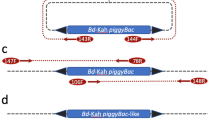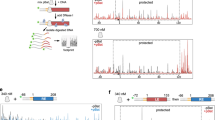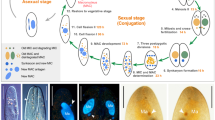Abstract
With the availability of complete genome sequence for Drosophila melanogaster, one of the next strategic goals for fly researchers is a complete gene knockout collection. The P-element transposon1, the workhorse of D. melanogaster molecular genetics, has a pronounced nonrandom insertion spectrum2. It has been estimated that 87% saturation of the ∼13,500-gene complement of D. melanogaster3 might require generating and analyzing up to 150,000 insertions2. We describe specific improvements to the lepidopteran transposon piggyBac4 and the P element that enabled us to tag and disrupt genes in D. melanogaster more efficiently. We generated over 29,000 inserts resulting in 53% gene saturation and a more diverse collection of phenotypically stronger insertional alleles. We found that piggyBac has distinct global and local gene-tagging behavior from that of P elements. Notably, piggyBac excisions from the germ line are nearly always precise, piggyBac does not share chromosomal hotspots associated with P and piggyBac is more effective at gene disruption because it lacks the P bias for insertion in 5′ regulatory sequences.
This is a preview of subscription content, access via your institution
Access options
Subscribe to this journal
Receive 12 print issues and online access
$259.00 per year
only $21.58 per issue
Buy this article
- Purchase on SpringerLink
- Instant access to full article PDF
Prices may be subject to local taxes which are calculated during checkout




Similar content being viewed by others
References
Adams, M.D. & Sekelsky, J.J. From sequence to phenotype: reverse genetics in Drosophila melanogaster. Nat. Rev. Genet. 3, 189–198 (2002).
Spradling, A.C. et al. The BDGP gene disruption project: single P element insertions mutating 25% of vital Drosophila genes. Proc. Natl. Acad. Sci. USA 153, 135–177 (1999).
Adams, M.D. et al. The Genome Sequence of Drosophila melanogaster. Science 287, 2185–2195 (2000).
Handler, A.M. & Harrell, R.A.I. Germline transformation of Drosophila melanogaster with the piggyBac transposon vector. Insect Mol. Biol. 8, 449–457 (1999).
Handler, A.M. A current perspective on insect gene transformation. Insect Biochem. Mol. Biol. 31, 111–128 (2001).
Horn, C., Offen, N., Nystedt, S., Häcker, U. & Wimmer, E.A. piggyBac-based insertional mutagenesis and enhancer detection as a tool for functional insect genomics. Genetics 163, 647–661 (2003).
Hacker, U., Nystedt, S., Barmchi, M.P., Horn, C. & Wimmer, E.A. piggyBac-based insertional mutagenesis in the presence of stably integrated P elements in Drosophila. Proc. Natl. Acad. Sci. USA 100, 7720–7725 (2003).
Zhang, P. & Spradling, A.C. Efficient and dispersed local P element transposition from Drosophila females. Genetics 133, 361–373 (1993).
Ashburner, M.A. Drosophila: a Laboratory Handbook (Cold Spring Harbor Laboratory Press, New York, 1989).
Cooley, L., Kelley, R. & Spradling, A.C. Insertional mutagenesis of the Drosophila genome with single P elements. Science 239, 1121–1128 (1988).
Rørth, P. A modular misexpression screen in Drosophila detecting tissue-specific phenotypes. Proc. Natl. Acad. Sci. USA 93, 12418–12422 (1996).
Spradling, A.C. et al. Gene disruptions using P transposable elements: an integral component of the Drosophila genome project. Proc. Natl. Acad. Sci. USA 92, 10824–10830 (1995).
Horowitz, H. & Berg, C.A. Aberrant splicing and transcriptional termination caused by P element insertion into the intron of a Drosophila gene. Genetics 139, 327–335 (1995).
Goodwin, S.F. et al. Aberrant splicing and altered spatial expression patterns in fruitless mutants of Drosophila melanogaster. Genetics 154, 725–745 (2000).
Cho, N. et al. Developmental control of blood cell migration by the Drosophila VEGF pathway. Cell 108, 865–876 (2002).
Gottar, M. et al. The Drosophila immune response against Gram-negative bacteria is mediated by a peptidoglycan recognition protein. Nature 416, 640–644 (2002).
Pirrotta, V. Vectors for P mediated transformation in Drosophila. in Vectors: A Survey of Molecular Cloning Vectors and Their Uses (eds. R.L. Rodriquez & D.T. Denhart) 437–456 (Butterworth, Boston, 1988).
Sadowski, P. The Flp recombinases of the 2-microns plasmid of Saccharomyces cerevisiae. Prog. Nucleic Acid Res. Mol. Biol. 51, 53–91 (1995).
Kim, Y.J., Zuo, P., Manley, J.L. & Baker, B.S. The Drosophila RNA-binding protein RBP1 is localized to transcriptionally active sites of chromosomes and shows a functional similarity to human splicing factor ASF/SF2. Genes Dev. 6, 2569–2579 (1992).
Roseman, R.R. et al. A P element containing suppressor of Hairy-wing binding regions has novel properties for mutagenesis in Drosophila melanogaster. Genetics 141, 1061–1064 (1995).
Parks, A.L. et al. Systematic generation of high-resolution deletion coverage of the Drosophila melanogaster genome. Nat. Genet. advance online publication, 22 February 2004 (doi:10.1038/ng1312).
Golic, K.G. & Lindquist, S. The FLP recombinase of yeast catalyzes site-specific recombination in the Drosophila genome. Cell 59, 499–509 (1989).
Theurkauf, W.E., Baum, H., Bo, J. & Wensink, P.C. Tissue-specific and constitutive α-tubulin genes of Drosophila melanogaster code for structurally distinct proteins. Proc. Natl. Acad. Sci. USA 83, 8477–8481 (1986).
Serano, T.L. & Cohen, R.S. A small predicted stem-loop structure mediates oocyte localization of Drosophila K10 mRNA. Development 121, 3809–3818 (1995).
Rørth, P. Gal4 in the Drosophila female germline. Mech. Dev. 78, 113–118 (1998).
Robertson, H.M. et al. A stable genomic source of P element transposase in Drosophila melanogaster. Genetics 118, 461–470 (1988).
Acknowledgements
We thank the many other people at Exelixis whose intellectual and technical contributions made this work possible, particularly our colleagues in the Genomics, Informatics and Genetics departments.
Author information
Authors and Affiliations
Corresponding author
Ethics declarations
Competing interests
The authors are presently or were recently employed (while engaged in research on this project) by Exelixis. They may hold shares of common stock in Exelixis.
Rights and permissions
About this article
Cite this article
Thibault, S., Singer, M., Miyazaki, W. et al. A complementary transposon tool kit for Drosophila melanogaster using P and piggyBac. Nat Genet 36, 283–287 (2004). https://doi.org/10.1038/ng1314
Received:
Accepted:
Published:
Issue date:
DOI: https://doi.org/10.1038/ng1314
This article is cited by
-
Tyrosyl-tRNA synthetase has a noncanonical function in actin bundling
Nature Communications (2023)
-
Remodelling of oxygen-transporting tracheoles drives intestinal regeneration and tumorigenesis in Drosophila
Nature Cell Biology (2021)
-
Unpredictable recombination of PB transposon in Silkworm: a potential risk
Molecular Genetics and Genomics (2021)
-
Chromosome mapping of attP landing sites in the strains for phiC31 integrase-mediated transgenesis of Drosophila prolongata (Diptera: Drosophilidae)
Applied Entomology and Zoology (2021)
-
Emerging mechanisms of cell competition
Nature Reviews Genetics (2020)



